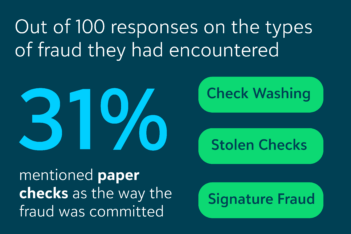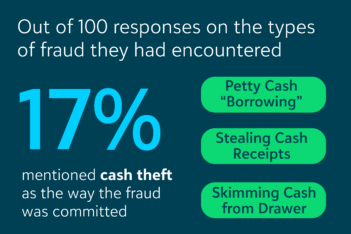In the course of the latest webinar, Unmasking Fraud in Not-for-Income: 5 Key Schemes and 5 Preventive Steps, we engaged with a whole lot of accounting and finance professionals from not-for-profit entities throughout the nation. People shared their ideas and views on the fraudulent exercise they’re seeing of their organizations and strategies to mitigate threat.
Under are the highest 4 fraud classes that emerged—phishing schemes, bank card fraud, test fraud and money theft—together with key insights to assist defend your group.
Risk #1: Phishing Scams and Electronic mail Fraud
In lots of phishing schemes, hackers both impersonate an electronic mail account or take over a trusted electronic mail account, utilizing a number of strategies to steal funds from organizations. The most typical ways embody:
- Present Card Scams: These scams usually contain social engineering, whereby a fraudster poses as a senior chief and makes an attempt to trick your staff into handing over delicate data with out having to crack your safety programs. The hacker requests somebody to buy reward playing cards for purchasers or colleagues after which asks for the numbers on the again of the playing cards, together with the PINs. As soon as they’ve this data, they rapidly use the reward playing cards on-line, leaving the group with the bills.
- Pretend Vendor Invoices: The hacker impersonates a vendor and sends a fraudulent bill for fee or makes an attempt to reroute common automated clearing home (ACH) funds. They use a rip-off method referred to as typosquatting, the place they register domains that look just like professional ones however comprise slight variations, equivalent to bankofarnerica.com (utilizing “rn” as an alternative of “m”), to deceive staff.
- Rerouting of Buyer Proceeds: After having access to a company’s electronic mail account, often somebody within the accounting division, the hacker sends invoices to prospects. These invoices seem professional however embody altered fee directions directing funds to the hacker’s checking account.
How you can Defend Your Group from Phishing Scams
Listed here are a number of methods you may assist your group keep away from falling for phishing scams.
- Implement safety consciousness coaching to assist staff acknowledge phishing makes an attempt and tried fraud.
- Use IT safety measures like Area-based Message Authentication, Reporting and Conformance (DMARC) and DomainKeys Recognized Mail (DKIM) electronic mail authentication processes or electronic mail filtering. Require multi-factor authentication on all accounts.
- Rent a cybersecurity specialist to conduct penetration testing, also called moral hacking. The specialist will try and hack into a company’s system to establish weaknesses in safety protocols.
- Prohibit private electronic mail entry on firm gadgets to cut back publicity to malware and phishing assaults.
- Encourage staff to pause and confirm pressing monetary requests—scammers create urgency to govern victims.
Risk #2: Credit score Card Fraud
Bank cards are a frequent concern for not-for-profits. The most typical sorts of fraud embody:
- Unauthorized private purchases: A certified worker makes use of a company-issued bank card for private objects, both by chance or deliberately.
- Compromised accounts: Hackers acquire an organization bank card’s data and use it for unauthorized purchases on-line or in individual with a cloned bank card.
How you can Defend Your Group from Credit score Card Fraud
Listed here are a number of methods to guard your group from unintended or fraudulent bank card use.
- Restrict the variety of firm bank cards and concern them solely to staff who want them for his or her jobs. Following a regular expense reimbursement coverage could also be a safer course of.
- Set inner insurance policies proscribing the quantity staff can spend on a bank card with out prior approval from a superior. Work together with your monetary establishment to set spending limits and service provider restrictions.
- Assessment bank card statements month-to-month and require staff to submit receipts or invoices for all purchases. Statements alone could not present sufficient element to tell apart enterprise from private bills.
- Set up clear bank card utilization insurance policies and revoke playing cards from staff who violate them. Small violations can escalate into fraud.
Risk #3: Examine Fraud and Theft

Although paper checks are lowering in reputation, test theft and fraud stay a menace to organizations. Nevertheless, your group can take steps to cut back the chance.
How you can Defend Your Group from Examine Fraud
With a number of modifications to your processes, you may lower the possibilities of your group experiencing test fraud.
- Use Optimistic Pay: This characteristic, provided by most banks, matches issued checks with these checks being introduced for fee. If particulars don’t match, the financial institution rejects the test. Seek the advice of together with your financial institution to find out which test traits they’ll confirm (e.g., payee, quantity, date) and the precise course of they use.
- Scale back reliance on bodily checks and think about ACH or an automated fee system that hides account particulars from distributors.
- Carry out well timed financial institution reconciliations to detect fraud early. Assign an worker with out check-signing authority to deal with financial institution reconciliations.
- Require twin signatures on checks above a specific amount. Whereas banks could not implement this requirement, it will increase each actual and perceived fraud detection.
- Observe U.S. Postal Inspector suggestions for mailing checks.
- Drop checks off on the submit workplace.
- Hand envelopes containing checks on to a mail service.
- Drop checks in a blue United States Postal Service (USPS) assortment field earlier than the final pickup of the day to stop in a single day theft.
- Use gel ink pens, that are extra immune to test washing.
- Cancel and reissue stale checks. When required, escheat uncashed checks to the state.
Risk #4: Money Theft

With in-person occasions and volunteers, theft of petty money or donations and register skimming are frequent points for not-for-profits.
How you can Defend Your Group from Money Theft
Listed here are a number of simple steps your group can take to restrict the alternatives for money theft.
- Decrease the variety of money assortment containers and areas.
- Guarantee money containers are safe and, if doable, inside view of safety cameras. This may help in investigating any theft allegations and reduce the chance of theft by rising the notion of detection.
- Conduct frequent money counts and reconcile to money register listings to detect discrepancies early.
- Be certain that when gathering money donations, there’s all the time a couple of worker current.
Key Takeaways
Whereas not-for-profits function with a mission-driven focus, they aren’t proof against fraud dangers. Being proactive is the very best protection and there are easy steps organizations can take at this time. In response to the Affiliation of Licensed Fraud Examiner’s Report back to the Nations, the longer the fraud goes undetected, the higher the monetary loss. If stopping fraud will not be doable, detecting it early is essential. By implementing these safeguards, your group can cut back vulnerabilities and be sure that monetary assets stay devoted to your mission.
Jon Klerowski, CPA, CFE, ABV; Alexander Buchholz, CPA, MBA, CGMA; and Robert Gaines, CISSP, CECI, CCFI and C|OSINT co-authored this submit.

